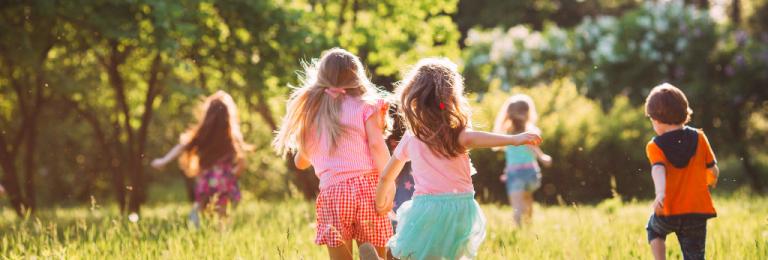Creating a Physical Activity Promoting Environment in an Early Years Setting
The 24-Hour Movement Guidelines for the Early Years by the Canadian Society for Exercise Physiology (Early Years 0-4 Years – 24-Hour Movement Guidelines, n.d.) outlines the recommended balance of physical activity, high-quality sedentary behaviour and sufficient sleep for healthy growth and development. However, much research has shown that many children do not meet these guidelines.
For children who are 3-4 years old, the guidelines recommend at least 180 minutes of physical activity every day, in which at least 60 minutes is ‘energetic play’, each day during their waking hours. Specific to childcare environments, the Director of Licensing Standard of Practice - Active Play (DOLSOP) recommends 120 minutes of active play, specifically outdoors, and requires at least 60 minutes*.
Research by Statler et al. (2020) found that across early years settings children engaged in approximately 70 minutes of active play each day. While this meets the required amount of active play stated in the DOLSOP, it is far short of the recommended amount.
While these results are concerning, further research and analysis of policies and practices in place at settings throughout the world has outlined broad recommendations that can be established to create a physical activity promoting environment (Lum et al., 2022). It is purported that by implementing the following components physical activity within an early years setting will increase:
Provide opportunities for children to be physically active
While this recommendation may seem obvious, there are specific traits to the opportunities that children engage in that are important:
Outdoor free play increases physical activity levels more than indoor free play. However, it is important to note that physical activity levels in outdoor free play are significantly reduced after approximately 10 minutes.
Opportunities for physical activity should also include educator-directed learning games and playful learning that focuses on the development of fundamental movement skills.
When engaging children in physical activity, it has been shown that an adult actively participating in the activity leads to greater participation rates for the children.
Offer educator training to provide safe and developmentally appropriate physical activity
Educator training is a key component in building the knowledge and self-efficacy of practitioners to facilitate activities that engage children throughout the spectrum of play-based learning in physical activity. Seeking ‘expert’ advice and strategies for implementing physical activity within a setting has been shown to result in significant changes in measured physical activity levels.
Educators to promote the benefits of physical activity with children
This component is two-fold, relating to both the behaviours of the educator themselves and their actions when engaging with children:
Educators as role models - educators should strive to be role models for physical activity by engaging in activity with the children within the setting and during personal time.
Positive reinforcement and encouragement - both of these components have been shown to increase the engagement in physical activity of children in early years settings. These findings show that the language and attitude of educators towards physical activity impacts the activity levels of the children.
Create a physical environment that promotes physical activity
When looking to create an environment for physical activity, the availability of equipment has been consistently shown to increase physical activity levels. There should be a high ratio of equipment to children, the equipment should be portable in that it can be moved and manipulated, it should be varied in size, weight and texture and it should be accessible at all times.
By implementing these broad recommendations, early years settings are able to create an environment that values and promotes physical activity through teacher knowledge and child engagement.
*This amount changes depending on the length of the program:
If program is 1 - 2 hours, 20 minutes is required
If program is 2 - 3 hours, 30 minutes is required
If program is 3 - 4 hours, 40 minutes is required
References
- Early Years 0-4 Years – 24-Hour Movement Guidelines. (n.d.). Canadian Society for Exercise Physiology. Retrieved January 26, 2022, from https://csepguidelines.ca/guidelines/early-years/
- Lum, M., Wolfenden, L., Jones, J., Grady, A., Christian, H., Reilly, K., & Yoong, S. L. (2022). Interventions to Improve Child Physical Activity in the Early Childhood Education and Care Setting: An Umbrella Review. International Journal of Environmental Research and Public Health, 19(4). https://doi.org/10.3390/ijerph19041963
- Statler, J., Wilk, P., Timmons, B. W., Colley, R., & Tucker, P. (2020). Habitual physical activity levels and sedentary time of children in different childcare arrangements from a nationally representative sample of Canadian preschoolers. Journal of Sport and Health Science, 9(6), 657–663.
